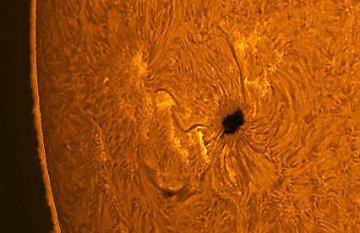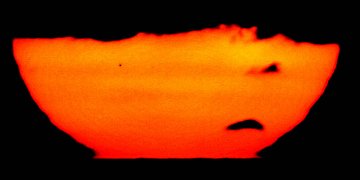 Autumn is here, and it's a wonderful time for stargazing. Find out what's up from Spaceweather PHONE.
Autumn is here, and it's a wonderful time for stargazing. Find out what's up from Spaceweather PHONE.
FOUR PLANETS: Jupiter, Venus, Mars and Mercury are all crowded around the sun this weekend. The great conjunction is invisible to the human eye (too much sunlight), but SOHO can see it. The spacecraft's coronagraph is able to block the glare and reveal the planets. Take a look: live image, finder chart.
SOLAR ACTIVITY: Big sunspot 923 resembles a ferocious sea monster--with a great black maw and magnetic tentacles reaching out to gather its prey:

Sunspot 923, the view through a SolarMax90. Credit: Greg Piepol.
What a facade. This sunspot is utterly docile. Since it rounded the sun's eastern limb last week, the behemoth has unleashed no big solar flares and expelled zero CMEs. (This weekend's auroras were caused by an unrelated solar wind stream.) Why so quiet? The sunspot's magnetic field does not contain the sort of tangles and kinks that lead to instabilities and explosions. This could change, but for now sunspot 923 is merely photogenic.
More images: from Ronnie W. Sherrill of Statesville, NC; from Mike Strieber of Las Vegas, NV; from Paul Russell of Queensland, Australia; from Howard Eskildsen of Ocala, FL.
TRANSIT OF MERCURY: When the Transit of Mercury began last Wednesday, Nov. 8th, the sun had already begun to set over the tiny Caribbean island of St. Maarten. This gave island photographer Stephen Thompson a chance to take a truly unusual picture:

"The sun was less than 0.5o above the water," says Thompson. Low-hanging clouds blocked the top of the sun while a layer of warm air near the sea surface stretched the sun into a strangely-shaped mirage. Mercury, meanwhile, was little affected. It is the tiny circular dot just left of center.
"The lower 'flange' is an inverted image of the sun," notes atmospheric optics expert Les Cowley. "If only Mercury had transited the sun closer to the ocean we might have seen it imaged twice."
Transit of Mercury Photo Gallery

